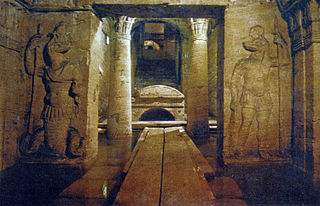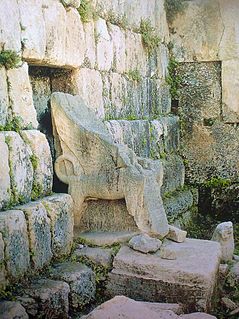 W
WThe Antikythera Ephebe, registered as: Bronze statue of a youth in the museum collections, is a bronze statue of a young man of languorous grace that was found in 1900 by sponge-divers in the area of the ancient Antikythera shipwreck off the island of Antikythera, Greece. It was the first of the series of Greek bronze sculptures that the Aegean and Mediterranean yielded up in the twentieth century which have fundamentally altered the modern view of ancient Greek sculpture. The wreck site, which is dated about 70–60 BC, also yielded the Antikythera mechanism, a characterful head of a Stoic philosopher, and a hoard of coins. The coins included a disproportionate quantity of Pergamene cistophoric tetradrachms and Ephesian coins, leading scholars to surmise that it had begun its journey on the Ionian coast, perhaps at Ephesus; none of its recovered cargo has been identified as from mainland Greece.
 W
WThe Antikythera wreck is a Roman-era shipwreck dating from the second quarter of the first century BC.
 W
WThe Arcisate Treasure is a Roman silver hoard found in the town of Arcisate, northern Italy. Soon after its discovery in 1900, the treasure was acquired by the British Museum According to scholars, the treasure's significance is due to the completeness of the set, the high quality of the craftsmanship and materials used to make it, as well as the hoard's excellent state of preservation.
 W
WThe catacombs of Kom El Shoqafa is a historical archaeological site located in Alexandria, Egypt, and is considered one of the Seven Wonders of the Middle Ages.
 W
WThe Dunhuang manuscripts are a cache of important religious and secular documents discovered in the Mogao Caves of Dunhuang, China, in the early 20th century. Dating from late 4th to early 11th centuries, the manuscripts include works ranging from history and mathematics to folk songs and dance. There are also many religious documents, most of which are Buddhist, but other religions including Daoism, Nestorian Christianity and Manichaeism are also represented. The majority of the manuscripts are in Chinese. Other languages represented are Khotanese, Kuchean, Sanskrit, Sogdian, Tangut, Tibetan, Old Uyghur language, Prakrit and Old Turkic. The manuscripts are a major resource for academic studies in a wide variety of fields including history, religious studies, linguistics, and manuscript studies.
 W
WThe Layer Pyramid is a ruined step pyramid dating to the 3rd Dynasty of Egypt and located in the necropolis of Zawyet El Aryan. Its ownership is uncertain and may be attributable to pharaoh Khaba. The pyramid architecture, however, is very similar to that of the Buried Pyramid of king Sekhemkhet and for this reason is firmly datable to the 3rd Dynasty.
 W
WLinear B is a syllabic script that was used for writing Mycenaean Greek, the earliest attested form of Greek. The script predates the Greek alphabet by several centuries. The oldest Mycenaean writing dates to about 1450 BC. It is descended from the older Linear A, an undeciphered earlier script used for writing the Minoan language, as is the later Cypriot syllabary, which also recorded Greek. Linear B, found mainly in the palace archives at Knossos, Cydonia, Pylos, Thebes and Mycenae, disappeared with the fall of Mycenaean civilization during the Late Bronze Age collapse. The succeeding period, known as the Greek Dark Ages, provides no evidence of the use of writing. Linear B, deciphered by English architect and self-taught linguist Michael Ventris—based on the research of American Classicist Alice Kober—is the only Bronze Age Aegean script to have thus far been deciphered.
 W
WMinisink Archeological Site, also known as Minisink Historic District, is an archeological site of 1320 acres located in both Sussex County, New Jersey and Pike County, Pennsylvania. It was part of a region occupied by Munsee-speaking Lenape that extended from southern New York across northern New Jersey to northeastern Pennsylvania. The Munsee were speakers of one of the three major language dialects of the Lenape Native American tribe. This interstate territory became the most important Munsee community for the majority of the 17th and 18th centuries.
 W
WThe Saint-Bélec slab is a stone artefact from western Brittany thought to be a map of an early Bronze Age principality. It was discovered by Paul du Châtellier in a prehistoric burial ground in Finistère, where it formed part of an early Bronze Age cist structure. Du Châtellier kept the slab at his house, the Château de Kernuz, before it came into the collection of the National Archaeological Museum. It was forgotten until 2014 when it was rediscovered in the cellar of the château. A 2017–2021 study by French and British universities and institutes identified the slab as an early Bronze Age map of part of the Odet valley. The slab is the earliest known map found in Europe and probably the earliest map of any known territory.
 W
WShuruppak, modern Tell Fara, was an ancient Sumerian city situated about 55 kilometres south of Nippur on the banks of the Euphrates in Iraq's Al-Qādisiyyah Governorate. Shuruppak was dedicated to Ninlil, also called Sud, the goddess of grain and the air.
 W
WThe Temple of Eshmun is an ancient place of worship dedicated to Eshmun, the Phoenician god of healing. It is located near the Awali river, 2 kilometres (1.2 mi) northeast of Sidon in southwestern Lebanon. The site was occupied from the 7th century BC to the 8th century AD, suggesting an integrated relationship with the nearby city of Sidon. Although originally constructed by Sidonian king Eshmunazar II in the Achaemenid era to celebrate the city's recovered wealth and stature, the temple complex was greatly expanded by Bodashtart, Yatan-milk and later monarchs. Because the continued expansion spanned many centuries of alternating independence and foreign hegemony, the sanctuary features a wealth of different architectural and decorative styles and influences.
 W
WThe Throne Room was a chamber built for ceremonial purposes during the 15th century BC inside the palatial complex of Knossos, Crete, in Greece. It is found at the heart of the Bronze Age palace of Knossos, one of the main centers of the Minoan civilization and is considered the oldest throne room in Europe.
 W
WThe Statuette of the lady Tiye is a wooden statue of a high-status woman from the reign of Amenhotep III to Akhenaten ; Dynasty 18 of the New Kingdom of ancient Egypt. Believed to depict a leading servant of the powerful Great Royal Wife Tiye, her title has been variously translated over the years as "Chief of Weavers" / "Chief of the Household" / "mistress of the harim". It is one of only about 160 wooden statues discovered from the New Kingdom. It currently resides in the Metropolitan Museum of Art.